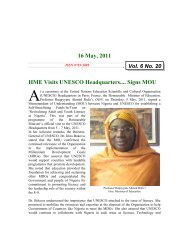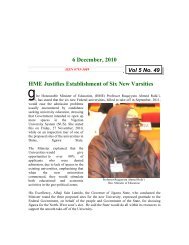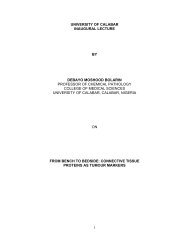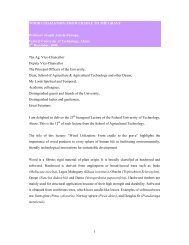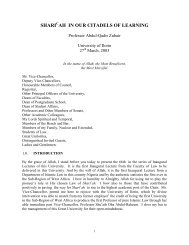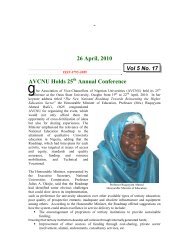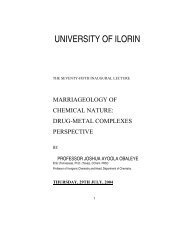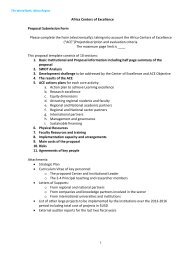THE VARIED ROLES OF SNAILS - National Universities Commission
THE VARIED ROLES OF SNAILS - National Universities Commission
THE VARIED ROLES OF SNAILS - National Universities Commission
You also want an ePaper? Increase the reach of your titles
YUMPU automatically turns print PDFs into web optimized ePapers that Google loves.
contracts and expands and this creates a kind of rippling<br />
movement that pushes the snail forward. The “foot” has a<br />
special gland that produces slimy mucus to make a slippery<br />
track. You can often see these silvery tracks in the garden.<br />
The slime comes out from the front and hardens when it<br />
comes into contact with air. The snail is able to move on<br />
very sharp pointed needles, knife, razors and vines without<br />
being injured because the mucus-like secretion helps to<br />
protect its body.<br />
The garden snail travels about 70 cm every 3 minutes-that’s<br />
1 km every three and a half days.<br />
Many snails are both male and female. Therefore, it can<br />
produce sperms and eggs at the same time! However, to<br />
fertilize the eggs, the snails need to exchange sperms with<br />
each other. An animal that is both a male and a female is<br />
called a hermaphrodite. This method of reproduction comes<br />
in very handy as these snails are very slow moving and<br />
don’t like moving around too much. If they had to go<br />
looking for a boyfriend or girlfriend, it could take them a<br />
very, very long time to have babies.<br />
The brown garden snail lays about 80 spherical shaped<br />
white or yellowish coloured eggs at a time into the topsoil<br />
of the ground. It can lay eggs up to six times a year. Snails<br />
take about 2 years to become adults.<br />
Snails have many natural enemies. They include ground<br />
beetles, snakes, toads, turtles, and birds, including<br />
chickens, ducks and geese.<br />
The largest known land snail is the Giant African Land<br />
Snail. It can weight up to 2lb (900g) and measure up to<br />
15.5 inches (39.3cm) from snout to tail.<br />
11




